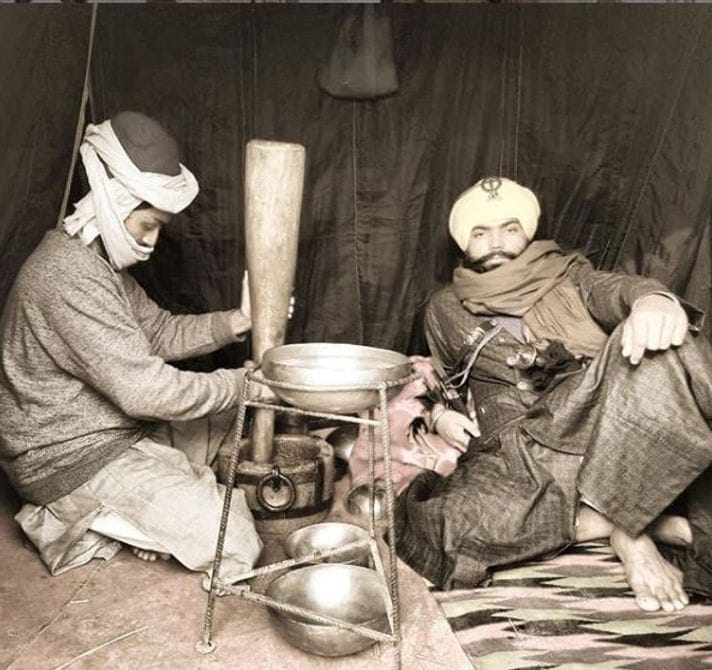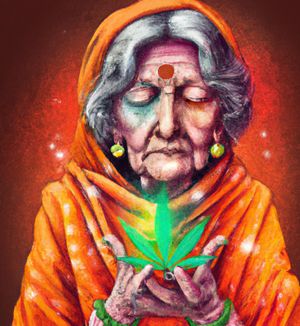A Brief History
Sikhism, founded in the 15th century in Punjab by Guru Nanak Dev Ji, has a rich tapestry of spiritual and cultural practices. Among these, the use of bhang (cannabis) as “Sukh Nidhaan” or “the peace giver” is particularly notable, especially among certain sects such as the Nihang Sikhs. This practice has historical roots and continues to be observed in modern times.
Historical Context
Nihang Sikhs: The Nihang Sikhs, known for their distinctive blue attire and martial prowess, have a long-standing tradition of using bhang. For over two centuries, bhang has been a part of their daily rituals, believed to aid in meditation, enhance focus, and provide the stamina needed for their martial lifestyle. The Nihangs often refer to bhang as “Sukh Nidhaan” (the peace giver).
Bhangi Misl: The Bhangi Misl, one of the prominent Sikh confederacies during the 18th century, derives its name from its members’ use of bhang. This misl played a significant role in the expansion of Sikh power in Punjab, and its leaders used bhang for its perceived benefits in enhancing endurance and bravery.
Spiritual Significance
Meditation and Prayer: Bhang is believed to help achieve a state of tranquility and concentration essential for deep meditation and prayer. The Nihang Sikhs incorporate bhang into their spiritual practices, viewing it as a sacred herb that facilitates divine connection.
Martial Prowess: Historically, Sikh warriors used bhang to bolster their physical stamina and composure in battle. The calming effects of bhang were thought to help warriors remain focused and fearless, even in the face of overwhelming odds.
References in Sikh Texts and Tradition
1. Guru Nanak and Bhang: There are accounts in Sikh tradition that during his imprisonment, Guru Nanak Dev Ji was offered bhang. Although not explicitly mentioned in the Guru Granth Sahib, these stories illustrate the cultural context of bhang within Sikh history.
2. Guru Gobind Singh Ji: According to the book ‘Khalsa Dharam Shaastar’, Guru Gobind Singh Ji ordered the use of certain intoxicants, including ‘Chhatar-dhara’ (opium) and ‘Sukh Nidhaan’ (bhang), to alleviate sadness. The quantities of these substances were prescribed for specific purposes.
3. Suraj Mal Parkash and Khalsa Dharam Shastar: Historical Sikh texts such as Suraj Mal Parkash and Khalsa Dharam Shastar provide detailed accounts of the use of bhang among Sikhs. The book ‘Sooraj Prakash’ contains descriptions of ‘Sukh Nidhaan’ on many pages, highlighting its significance in Sikh tradition.
4. Budhha Dal Nihangs: The Nihangs of the Budhha Dal, a prominent Nihang group, offer ‘Sukh Nidhaan’ as part of their rituals. This practice is a continuation of the historical usage of bhang among the Nihangs.
5. Modern Usage and Consumption: At locations such as Sri Anandpur Sahib, Sri Amritsar Sahib, and Taran-taaran, ‘Sukh Nidhaan’ is still prepared and offered. For instance, at ‘Shaheedi Baag’ in Sri Anandpur Sahib, a room from Guru Sahib’s time was excavated, revealing big ‘Suneharas’ (large vessels) used to prepare ‘Sukh Nidhaan’. This indicates the historical continuity of this practice.
6. Hola Mohalla: Hola Mohalla, a three-day Sikh festival celebrated with mock battles, displays of martial skills, and religious ceremonies, also includes the preparation and offering of ‘Sukh Nidhaan’. This festival underscores the enduring cultural and spiritual significance of bhang in Sikhism.

Conclusion
The use of bhang as “Sukh Nidhaan” among Sikhs, especially the Nihang sect, represents a unique intersection of spirituality and martial tradition. Through centuries, bhang has been integrated into Sikh practices, aiding in meditation, prayer, and combat readiness. Historical records, Sikh texts, and oral traditions provide a comprehensive understanding of this practice, highlighting its significance in Sikh culture.
For further detailed exploration and specific citations, one can refer to historical Sikh texts like Suraj Mal Parkash and Khalsa Dharam Shastar, British colonial records, and contemporary scholarly works on Sikh traditions.




